
Coriander Seeds
Buy high-quality coriander seeds at D.T. Brown as part of our extended collection of herb seeds. Being a simple herb to grow, it’s ideal for both beginner and experienced gardeners to grow alike.
This herb is excellent when used in curries and with all red meat sausages and casseroles. Coriander's fresh citrus taste makes it an invaluable garnish and flavour enhancer. For the strongest flavour, add it to dishes just before serving.
For freshly grown herbs to bring out the best in your cooking, shop our coriander seeds today!

Growing Coriander Seeds
Coriander seeds can be sown all year round on a windowsill or sown outdoors. For a year-round windowsill supply, sow indoors at a depth of 0.5cm (¼in) in small plastic grow pots at a temperature of 15-20°C (60-65°F). Keep well watered and harvest individual leaves from plants or use thinnings until plants reach full size. For a winter supply indoors, sow from July to September. Germination will usually take between 7-20 days. Sow every three or four weeks for a constant supply of leaves.
Sow outdoors from March to June in their final position and thin out to 20cm (8in) apart. Water well. For a continuous supply, make sowings at two to three-week intervals. If growing for seed production, thin out to 10cm (4in) between plants in full sun.
Protect autumn-sown seeds with garden cloches for early winter use. Keep compost damp, as dry soil can cause plants to bolt or flower prematurely. If growing for seeds, pick them when ripe, just before they start to fall to the ground. Cut the entire stems and allow them to dry on paper. When fully dry, store in airtight containers. Either use whole or ground to a coarse powder with a pestle and mortar.
Order Your Coriander Seeds Today
At D.T. Brown, we have been selling herb plants and seeds to UK home gardeners for over a century. From mint seeds to fennel seeds, all of our herb seeds are stringently tested for the highest germination rates – 100% satisfaction guaranteed.
Order your coriander seeds from D.T. Brown. Shop now and enjoy fast UK delivery, with P&P from just £2.45 on seed-only orders.
We aim to dispatch all UK seed orders within 3-5 working days, and anything else within 5-7 working days. Live products will be dispatched at their optimum time for planting.





